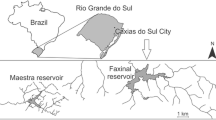Abstract
Grazing of C. quadrangula from a Siberian forest pond on natural phytoplankton assemblages was studied in a modified flow-through system. Ceriodaphniastrongly selected subdominant Cryptomonas erosarather than the dominant diatoms of comparable size. Using Cryptomonas as the sole microalgae food, Ceriodaphnia demonstrated significant somatic and population growth. Seasonal biomass maximum of Ceriodaphnia and Cryptomonas coincidedin the pond. Although bacterial component cannot be excluded, it was concluded that Cryptomonaswas the principal algal food source for Ceriodaphnia.
Similar content being viewed by others
References
Ahlgren G, Lundstedt L, Brett M and Forsberg C (1990) Lipid composition and food quality of some freshwater phytoplankton for cladoceran zooplankters. J Plankton Res 12: 809–818
Alimov AF (1989) An Introduction to production hydrobiology. Gidrometeoizdat, Leningrad (in Russian)
Balushkina EV and Vinberg GG (1979) Relation between mass and body size of plankton animals. In: Vinberg GG (ed.), General backgrounds for study of aquatic ecosystems. (pp. 169–172) Nauka, Leningrad (in Russian)
Bern L (1990) Size-related discrimination of nutritive and inert particles by freshwater zooplankton. J Plankton Res 12: 1059–1067
Burns CW and Hegarty B (1994) Diet selection by copepods in the presence of cyanobacteria. J Plankton Res 16: 1671–1690
Campbell RC (1967) Statistics for biologists. Cambridge University Press, Cambridge
Carpenter SR and Kitchell JF (1988) Consumer control of lake productivity. BioScience 38: 764–769
Corner ED (1961) On the nutrition and metabolism of zooplankton. I. Preliminary observations on the feeding of the marine copepod, Calanus helgolandicus. J Marine Biol Assoc UK 41: 5–16
Gladyshev MI (1993) A device for staining of zooplankton in order to allow live/dead sorting of preserved samples. Gidrobiologichesskii Zh 29: 94–97 (translated into English)
Gladyshev MI Temerova TA Degermendzhy AG and Tolomeev AP (1993) Kinetic characteristics of growth of zooplankton in flowing and closed cultivators. Dokl Akad Nauk 333: 795–797 (translated into English)
Gladyshev MI Temerova TA Shchur LA Degermendzhy AG and Tolomeev AP (1994) Real and imaginary microalgae feeding spectrum of Simocephalus sp. in flowing and closed cultivators. Dokl Akad Nauk 336: 843–846 (translated into English)
Gulati RD and De Mott W (1997) The role of food quality for zooplankton: remarks on the state-of-the-art, perspectives and priorities. Freshwat Biol 38: 731–738
Kerfoot WC and Kirk KL (1991) Degree of taste discrimination among suspension feeding cladocerans and copepods: Implications for detritivory and herbivory. Limnol Oceanogr 36: 1107–1123.
Knisley K and Geller W (1986) Selective feeding of four zooplankton species on natural lake phytoplankton. Oekologia 69: 86–94
Lehman JT and Sandgren CD (1985) Species-specific rates growth and grazing loss among freshwater algae. Limnol Oceanogr 30: 34–46
Muller-Navarra D (1995) Evidence that a highly unsaturated fatty acid limits Daphnia growth in nature. Arch Hydrobiol 132: 297–307
Reynolds CS (1984) The ecology of freshwater phytoplankton. Cambridge University Press, Cambridge
Roman MR and Rublee PA (1980) Containment effect in copepod grazing experiments: A plea to end the black box approach. Limnol Oceanogr 25: 982–990
Seepersad B and Crippen RW (1978) Use of aniline blue for distinguishing between live and dead freshwater zooplankton. J Fish Res Boad Canada 35: 1363–1366
Shapiro J and Wright DI (1984) Lake restoration by biomanipulation: Round Lake, Minesota, the first two years. Freshwat Biol 4: 371–383
Stewart AJ and Wetzel RG (1986) Cryptophytes and other microflagellates as couplers in planktonic community dynamics. Arch Hydrobiol 106: 1–19
Stich H-B and Lampert W (1984) Growth and reproduction of migrating and non-migrating Daphnia species under simulated food and temperature conditions of diurnal vertical migration. Oecologia 61: 192–196
Author information
Authors and Affiliations
Rights and permissions
About this article
Cite this article
Gladyshev, M.I., Temerova, T.A., Dubovskaya, O.P. et al. Selective grazing on Cryptomonas by Ceriodaphnia quadrangula fed a natural phytoplankton assemblage. Aquatic Ecology 33, 347–353 (1999). https://doi.org/10.1023/A:1009916209394
Issue Date:
DOI: https://doi.org/10.1023/A:1009916209394




